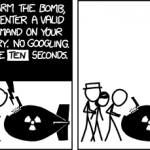NSF figures out how to support it’s own educational communities and resources
The Nanotechnology for Undergraduate Education program at NSF managed to do for nanoHUB.org what NSF was unable to do with the rest of their STEM education programs for NSDL. They’ve managed to make it a requirement to use their centrally supported resource center the primary dissemination mechanism for the funded projects. It’s a requirement as compared with strongly encouraged.
NSF Nanotechnology Undergraduate Education (NUE) RFP says:
NUE awardees are required to publish all educational content, assessment instruments, and learning results of their programs on nanoHUB.org. The goal is to connect NUE projects with a large community of over 240,000 users interested in nanoscale engineering and science education worldwide through a reliable and easy to use cyber-environment. In addition, NUE awardees are required to host their entire NUE program web page on nanoHUB.
The NSF Transforming Undergraduate Education in Science, Technology, Engineering and Mathematics (TUES) RFP (probably primary STEM education program at NSF) says:
Principal Investigators are strongly encouraged to take advantage of the National STEM Distributed Learning (NSDL) resources for project dissemination. This involves contributing metadata about project sites and individual resources. Guidelines for contribution may be found at http://nsdl.org/contribute. NSDL resources also offer an array of technology tools and community support services that may be of utility to TUES projects, including resource cataloging and collection management tools, as well as group workspaces and collaboration, outreach, and professional development opportunities. Inquiries may be submitted via http://nsdl.org/about/contactus. PIs may want to include funds in their budgets to cover required cataloging/metadata and/or software engineering expertise. They should contact the NSDL portal directly (http://nsdl.org/about/contactus/) to obtain more specific guidance on cost estimates for collection building and contribution to NSDL resources.
And even this language in the TUES and it’s precursor CCLI programs was a very long time in coming.


